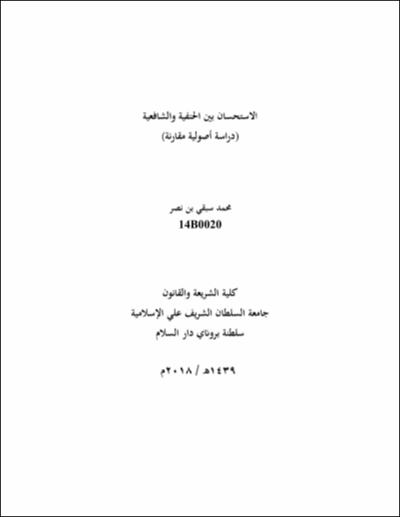| dc.contributor.author | Sabqi bin Nasar | |
| dc.date.accessioned | 2020-09-10T00:27:32Z | |
| dc.date.available | 2020-09-10T00:27:32Z | |
| dc.date.issued | 2018 | |
| dc.identifier.uri | https://e-ilami.unissa.edu.bn:8443/handle/20.500.14275/3883 | |
| dc.description.abstract | This research aims to explain the reasons for the difference of istiḥsān between Íanafiyyah and shafiʻiyyah. The researcher relies on the descriptive method in terms of the definition of istiḥsān from Íanafiyyah and shafiʻiyyah and the types of istiḥsān by Íanafiyyah. The researcher uses some research tools, including: reference to books of the fundamentals of jurisprudence, researches and theses related to istiḥsān. Then he works on the exegesis of aÍÉdÊth and the sources. The results reached after the study and analysis of the authoritative istiḥsān between the Íanafiyyah and shafiʻiyyah that the difference between them is a terminology only. What is meant by the Íanafiyyah is not what is meant by the shafiʻiyyah. The concept of istiḥsān being denied by al-shāfiʻī is the act of istiḥsān more inclined based on using own whims without any proof. In fact, there is no dispute between them because making rulings without legal evidence is not permissible according to all
cholars. As for the types of istiÍsÉn by Íanafiyyah, the shafiʻiyyah use that, but not under the name of
istiÍsÉn. | en_US |
| dc.language.iso | Arabic | en_US |
| dc.publisher | Universiti Islam Sultan Sharif Ali | en_US |
| dc.subject | Istihsan | en_US |
| dc.title | (الاستحسان بين الحنفية والشافعية (دراسة أصولية مقارنة | en_US |
| dc.title.alternative | Istihsan: A Comparative Study on Al-Hanafi and Al-Shafi'i School of Thought | en_US |
| dc.type | Thesis | en_US |
| dc.faculty | Faculty of Shariah and Law | en_US |
| dc.additionalinformation | Page number: 102 pages. | en_US |
| dc.supervisor | الأستاذ الدكتور نعمان جغيم | en_US |
| dc.studentID | 14B0020 | en_US |
| dc.keyword | Istihsan | en_US |



